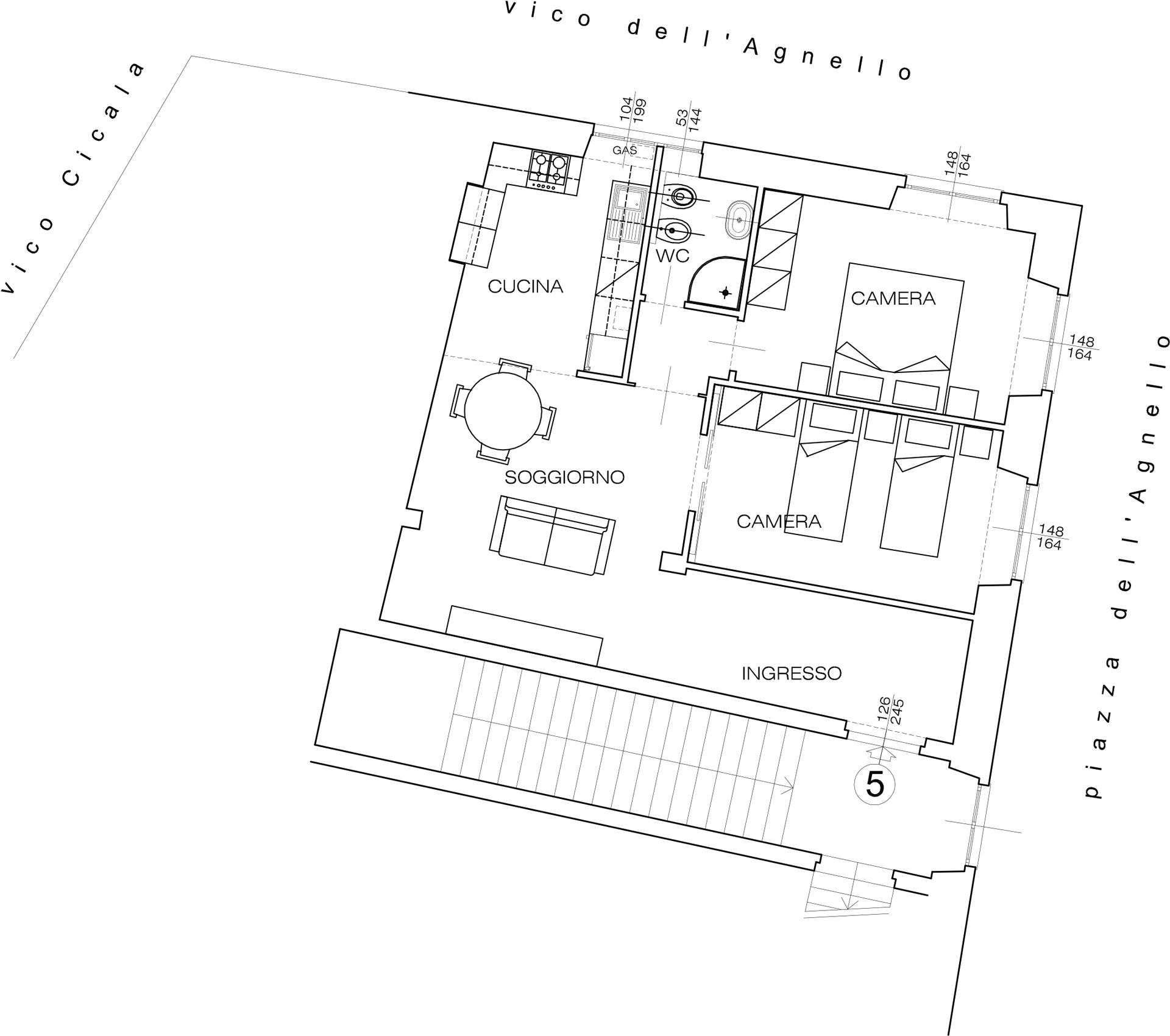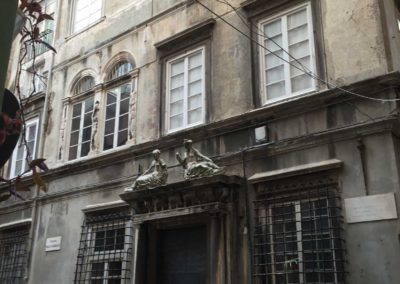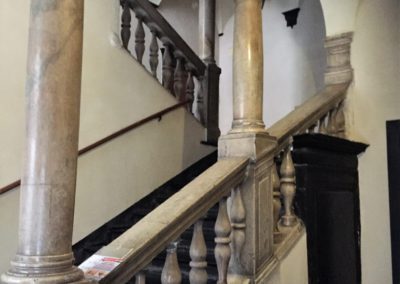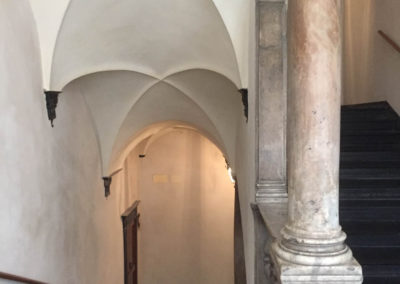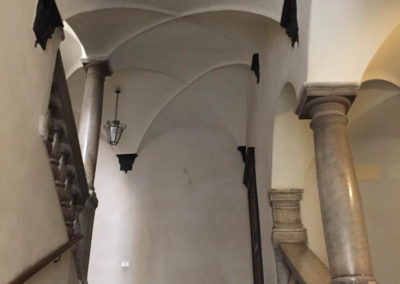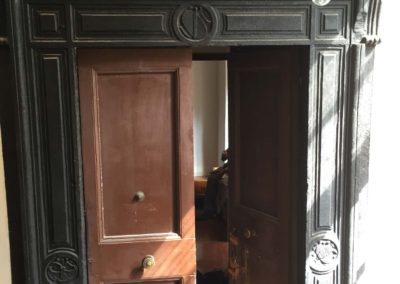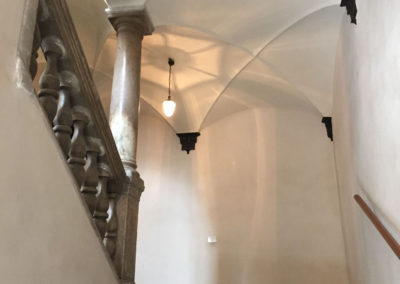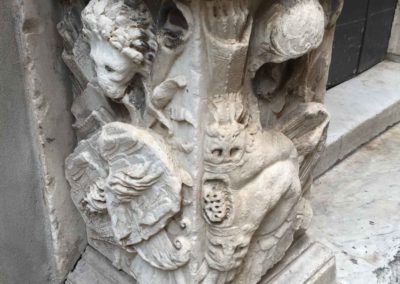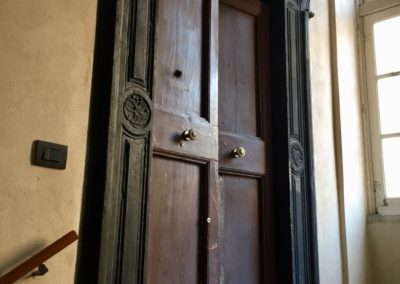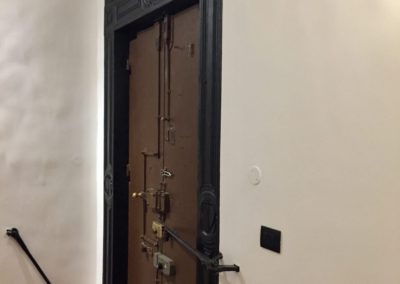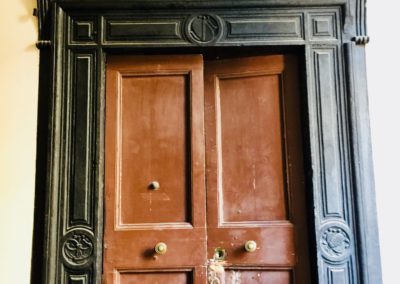Casa Ripa Maris

Rooms: 2

Bathrooms: 1

Beds: 4 (+2 extra)

90 mq
Facilities

Free Wi-Fi internet

Radio

TV Led

Hair-dryer

Dishwashing machine

Washing machine

Microwave

Iron (on demand)

Equipped kitchen
Planimetry
(Cod. Citra: 010025-LT-0528)
The apartment is located in a beautiful sixteenth century building named “Palazzo Cicala” in Piazza dell’Agnello 6, in the heart of the historical center of the city. Palazzo Cicala was built by Bernardino County in 1542 with decorations and frescos (facades) attributed to Lazzaro Calvi. The building is a Listed one (listed by the “Soprintendenza delle Belle Arti”) due to the highly historical, architectural and artistic value and it is part of “Palazzi dei Rolli” system (n. 79)
The house is strategically located for easy access to all the attractions and monuments of the city including the Aquarium and the Porto Antico (that are within a hundred meters away), San Lorenzo Cathedral, Palazzo Ducale and the splendid noble palaces ( “Palazzi dei Rolli”) of Via Garibaldi.
The apartment, recently renovated enhancing the historic features, has two bedrooms, a lounge, a bathroom with shower, a furnished kitchen for a total of about 90 sqm with all modern amenities. Furniture and decorations are inspired to a Mediterranean and nautical style mainly using materials from the Liguria to bring some sea flavor at home.
The train station is just a 15-minute walk, while the metro and taxi station are about a hundred meters away.
Location: Palazzo Cicala
The Palace, built in 1542 by Bernardino Cantone, has kept its structure unchanged through the years and is of great historical and artistic importance. The decorations (frescos) are attributed to Lazzaro Calvi, perhaps helped by his brother Pantaleo.
The House expresses a residential model of a noble family, with both formal and functional needs. The property at the time of construction is attributed to Nicola Cicala, however there are thesis that would attribute the first property to the Pallavicini family (in 1605 there are records referring to Carlo Pallavicino and his wife Nicoletta Spinola, two daughters, two servants and three minions).
In 1798, it was in possession of the “Monache Turchine della Chiappella” (a nuns order) and in 1902 of Joseph Saunier.
Casa dei Velieri
Bernardino Cantone
During this period, alongside his engagement in public works, Canone began to work actively as a private architect, with plans for several Genoese patrician houses (the first project of which you have knowledge, in 1542, was for the palazzo Cicala in piazza of the Lamb, and the following year in the palazzo Doria-Spinola, in collaboration with Giovanni Battista Castello).
In 1546 he succeeded to Francesco di Gandria as architect of the Municipality of Genova, a position that he held until old age. In this role, the most important public works project, in collaboration with Galeazzo Alessi, was the opening of Strada Nuova (1551), famous thanks to Rubens drawings published in the “volume Palazzi di Genova” (1622). Other activities range from consultancy to other architects, the renovation of dwellings up to complete design and construction of palaces and villas. Among the latter, several of the buildings facing the same Strada Nuova.
He died in Genoa between 1576-1580 and was buried in the Church of Nunziata.
What to visit
Old Town
One of the largest in Europe, Genoa’s historic centre unwinds in an intricate maze of alleyways (caruggi) that open unexpectedly onto small squares; the soul of the city lives here in these alleyways, where smells, tastes, and cultures have combined throughout history.
In these narrow spaces, tucked away between the hills and the sea, the pride of wealthy Genoese merchants, indomitable leaders of the Republic, had beautiful mansions built, in which works of art have been collected and preserved for centuries and are visible to this day in several house-museums.
In this dense urban landscape, where the windows are so close they almost touch, architectural styles are layered over one another, with a medieval wall serving as the base of a 14th-century building and Gothic loggias becoming trendy bars: this is a place where the past forms the foundations of the present.
In the centre, where time seems to have stood still, noble palaces and splendid churches alternate with historic shops that have been in operation for over 100 years, where local specialities are still prepared according to ancient recipes and handmade objects are crafted with timeless skill.
At the corners, be sure to lift your gaze to admire the magnificent votive niches donated by ancient guilds to illuminate the streets at night.
(source: www.visitgenoa.it)
Old shops
Genoa is a city closely bound up with tradition: in its historic centre, countless old shops can be found that have been in businesses for many years. Housed in centuries-old buildings woven into the fabric of the historic centre, the architecture, decor, tools and historical documents show that many of them have a history stretching back at least 50 years, and in some cases as long as two centuries.
To preserve this enormously significant heritage, a “Regional Register of Historic Shops” has been drawn up, listing businesses that have been in operation for at least 70 years and that meet a whole series of requirements set down by the Soprintendenza per i Beni Architettonici (Department for Architectural Heritage).
The shops currently featured on the register (http://www.botteghestorichegenova.it) are as follows:
- Abbigliamento Lucarda – Via Sottoripa, 61r – 16124 Genova
- Abbigliamento Pescetto – Via Scurreria, 8 – 16123 Genova
- Abbigliamento Pissimbono – Via XXV Aprile, 64r – 16123 Genova
- Antica Farmacia Sant’Anna – Piazza Sant’Anna, 8 – 16125 Genova
- Antica Tripperia La Casana – Vico della Casana, 3r – 16123 Genova
- Arduino Antiquariato – Via Garibaldi, 15 – 17r – 16124 Genova
- Argenteria Gismondi – Via Galata , 72-74r – 16121 Genova
- Bar Pasticceria Klainguti – Piazza Soziglia, 98r – 16123 Genova
- Barberia del Fai – Vico Caprettari, 14r – 16123 Genova
- Bottega Artigiana del Vetro – Piazza delle Scuole Pie 3 A – 16123 Genova
- Caffè, Confetteria e Pasticceria Mangini – Piazza Corvetto, 3r – 16122 Genova
- Calzature Stagno – Piazza Raffaele de Ferrari, 15r – 16121 Genova
- Confetteria Romanengo di Pietro Romanengo – Piazza Soziglia, 74/76r – 16123 Genova
- Confetteria Romanengo di Pietro Romanengo – Via Roma, 51/53r – 16123 Genova
- Cravatte e camicie Finollo & C – Via Roma, 38 – 16123 Genova
- Drogheria Torielli – Via di San Bernardo, 32 – 16128 Genova
- Drogheria Viganego – Via Colombo, 22r – 16121 Genova
- Fabbrica di cioccolato Viganotti di Romeo Viganotti – Vico dei Castagna, 14r – 16123 Genova
- Farmacia Alvigini – Via Petrarca, 14r – 16121 Genova
- Farmacia Sormani – Piazza Della Raibetta, 6r – 16123 Genova
- Libreria Antiquaria Dallai -Piazza de Marini, 11/13r – 16123 Genova
- Libreria Bozzi – Cairoli 2 R – 16124 Genova
- Macelleria Nico – Via Macelli di Soziglia, 8r – 16124 Genova
- Pasticceria di Cavo Marescotti – Via di Fossatello, 35r – 37r – 16124 Genova
- Pasticceria di Villa – Profumo – Via del Portello, 2r – 16124 Genova
- Pasticceria Svizzera Vital Gaspero – Albaro 5 – 9 – 16145 Genova
- Pasticceria Svizzera –
- Sa Pesta – Via dei Giustiniani, 16r – 16123 Genova
- Targhe e Timbri Busellato – Via Ponte Reale, 3r – 16126 Genova
- Teleria Rivara – Piazza San Lorenzo, 36r – 16123 Genova
- Turaccioli G. M. Luico – Salita Santa Caterina, 17r – 16121 Genova
- Uova e Pollame Aresu – Vico Inferiore del Ferro, 1 – 16124 Genova
- Zuccotti Fabbrica Cioccolato – Via di Santa Zita, 36r – 16129 Genova
(source: www.visitgenoa.it)
The Doges’ residence
The Doges’ residence since 1339, this building is today an exceptional venue for important events and prestigious activities.
Genoa’s Palazzo Ducale (Ducal Palace) is one of the city’s most prestigious symbols. Its construction began in 1298, when Genoa was asserting its economic power throughout the Mediterranean. The adjoining Palazzo Fieschi was incorporated into the new building, having been purchased by the Republic in 1294; part of the mediaeval building, to which the “Torre del Popolo”, or Grimaldina, belongs is still visible today.
Throughout the 14th and 15th centuries, new constructions were added to the Palace; in the 16th century, it was given a new appearance, deemed more appropriate than the original mediaeval construction for accommodating and enhancing the seat of the new Oligarchic Republic. In 1591, Andrea Ceresola, an architect from Ticino known as Il Vannone, was given the task of rebuilding the Palace: the result was a “monumental complex” characterised by a magnificent foyer flanked by two porticoed courtyards, and a broad staircase leading from the foyer to the rooms of the piano nobile, the reception rooms and the apartments of the Doge, with an annexed chapel.
The decor of the rooms inside also served to celebrate Genoa’s glorious endeavours. After the fire of 1777, the Palace was restored by Simon Cantoni, also from Ticino, who added neoclassical elements to the building. Following the work carried out in the 19th century and early 20th century, the Palace was subsequently restored to its former splendour by a complex restyling project and was opened to the city in 1992. With its 300,000 cubic meters, it was the largest restoration project carried out in Europe.
Today it has become the beating heart of cultural life in the city, offering a splendid venue for major events and quality exhibitions, as well as housing retail and entertainment facilities.
(source: www.visitgenoa.it)
West Riviera
The Riviera di Ponente stretches from the western province of Genoa to Ventimiglia, the last Italian town before France. The typical landscape of Liguria, a sliver of land stolen from the sea before leaving the space to the mountains, it does, to the west, less rough and steep.
The beaches of golden sand replacing the rocks and population centers become larger. Places of particular interest are Albenga, a town of Roman origin, Noli, Finale Ligure e Finalborgo, Alassio, an ancient fishing village and now major seaside resort, and San Remo, famous for its flowers and the music festival.
San Lorenzo’s Cathedral
Genoa’s cathedral was built circa 1098 in an area where archaeological excavations have revealed pre-existing Roman structures and the signs of an early basilica dating to the 5th or 6th century. Expanded over the centuries, the solemn, exquisite Cathedral of San Lorenzo preserves the ashes of St. John the Baptist, the patron saint of the city, which arrived in Genoa at the end of the First Crusade.
Beginning in the 9th century, San Lorenzo first supported then replaced the basilica of the Twelve Apostles as the city’s cathedral, dedicated to San Siro, a bishop of Genoa, since the 6th century. San Siro was (and indeed is to this day) located outside the ancient heart of the city, towards the West.
The relocation of the cathedral gave a boost to urban development in the area, with city walls built in 1155 and Genoa’s three ancient urban nuclei (the castrum, civitas and burgus) combining to become the heart of the city.
The consecration of the cathedral by Pope Gelasius II in 1118 marked the start of its reconstruction in Romanesque style; funds for the work arrived from the Crusades, other military ventures and city taxes.
Since 1133, the church has been the seat of the archbishop of Genoa. After the fire of 1296, the building was partly renovated and partly rebuilt: between 1307 and 1312 the façade was completed, the interior colonnades were rebuilt with capitals and false matronea, while preserving the Romanesque elements that were still in good condition, and the counter-façade was decorated with frescoes.
Several altars and chapels were erected between the 14th and 15th centuries; deserving of particular mention is the chapel designed to house the ashes of St. John the Baptist, a 15th century masterpiece in the left aisle. The small loggia on the north-east tower of the façade dates to 1455, and the one opposite, in the Mannerist style, to 1522.
In a city without squares and lacking a seat for secular power, the churchyard of San Lorenzo served as Genoa’s only public space throughout the Middle Ages, the stage upon which most of the city’s political and civil life was played out.
In 1550, by order of the city magistrates, the architect Galeazzo Alessi from Perugia designed a reconstruction of the entire building, but only completed the roofing of the nave and aisles, the floor, the dome and the area of the apse. The work was completed in the 17th century, when the apse was decorated with the “Stories of San Lorenzo” by Lazzaro Tavarone, in a triumph of gilded stucco work.
Modified further over the course of the centuries, restoration work carried out between 1894 and 1900 gave the cathedral its current appearance, making the most of the medieval elements that distinguish it to this day.
Other splendid attractions are the Museo del Tesoro, accessed from within the cathedral, and the neighbouring Museo Diocesano.
(source: www.visitgenoa.it)
Acquarium and Old Port
Acquarium
Inaugurated in 1992 for the celebrations of the 500th anniversary of Columbus’s discovery of the New World, the Aquarium welcomes over one million visitors every year.
Its 27,000 square metres of exhibition space offer visitors the chance to take a trip through the seas of the world in order to admire dolphins, sharks, penguins, manatees and Antarctic animals: it is the only facility in Europe to house jellyfish, tropical fish, seals and much more, in environments that faithfully reproduce the natural habitats of the different species represented.
Old port
Redesigned by Renzo Piano in 1992, Genoa’s Old Port area has now become a mecca for tourists, who come here to enjoy an aperitivo, dine, shop, take a trip to the cinema, ice skate, or go for a swim at the pool.
At the end of the pier, home to the Magazzini del Cotone, with the city’s Lanterna (lighthouse) rising up nearby, you can admire Genoa and its Gulf in all their beauty. The hills form a backdrop to this impressive panorama, brightly coloured by day and lit up at night.
In addition to the Aquarium, the area offers a host of attractions, such as the scenic Bigo lift (reminiscent – in both shape and name – of the port’s old loading cranes), the Biosphere, La Città dei Bambini (a funny, interactive museum for children aged 2 to 14), and the Museo Luzzati, housed within the ancient Porta Siberia defensive bulwark and dedicated to the famous Genoese set designer and the renovated Museo Nazionale dell’Antartide, which tells the story of Italy’s expeditions to Antarctica, the world’s most distant, mysterious continent.
(source: www.visitgenoa.it)
I “Palazzi dei Rolli” or Public Lodgings
Following the new architectural models of the time, Genoa’s nobility had many palaces of great splendour designed and built within the historic centre. The number and magnificence of these gave rise to a peculiar aristocratic residential system, formalised in 1576 by a Decree of the Senate that issued an official list of the dwellings (List of Public Lodgings, also known as Rolli), recognising their unique value. The same decree compelled the owners of the homes to take turns in hosting state visits, in the absence of a royal palace. Host dwellings were chosen in accordance with the importance of the visiting guest: the higher the guest’s noble rank, the more sumptuous the mansion that was required and the wealthier the family given the honour – and indeed the burden – of welcoming them.
The area featured on the UNESCO list also extends to the part of the historic centre that runs through Via Lomellini, Piazza Fossatello and Via San Luca to Piazza Banchi, the mercantile heart of the old town: along this stretch lie some of the most important examples of the Palazzi dei Rolli, woven in the modern age into the mediaeval fabric of the city.
The best way to experience the allure of some of these dwellings up close is to take one of the guided tours organised by the city.
Via Garibaldi
Via Garibaldi, the “Strada Nuova” (New Street) dating to the mid-16th century, is also known as “la Via Aurea” (the Golden Street). With its beautiful palaces, it boasts some of the world’s most fascinating architecture. Opened after 1550, to gather the city’s most important families into a single setting, it was originally called “Via Aurea” due to the splendour of its buildings, and then “via nuova delli palazzi” (the new street of palaces) until, at the end of the 1800s, the city decided to name it after Italy’s national hero Giuseppe Garibaldi.
The road represents a complex anthology that reiterates, in a Renaissance style and on a scale of particular grandeur, the enduring private entrepreneurship that can be seen in medieval Genoa’s most distant origins and for which the city’s leading families traditionally strived to group together in neighbourhoods that were ever more impressive in terms of splendour and architectural grandeur. Rubens was so struck by these palaces and their modern appearance that he assembled them in a volume of drawings to serve as examples for the important families of Antwerp.
Today the 14 buildings are home to the Town Hall, major banks, clubs, cultural groups, antique dealers, shops and public and private offices. The “Strade Nuove” (New Streets, comprising Via Garibaldi, Via Cairoli, and Via Balbi) form an urban layout composed mainly of two modern-age residential roads, created by the grandest families of the aristocracy, who built their dwellings on the edge of the historic centre in two consecutive periods (in the 16th and 17th centuries).
On 13 July 2006, the “Strade Nuove” were recognised as a UNESCO World Heritage Site, together with the “Palazzi dei Rolli”.
(source: www.visitgenoa.it)
I musei di Genova
Strada Nuova Museums
Since 2004, Palazzo Rosso, Palazzo Bianco and Palazzo Tursi – the three historical palaces owned by the Municipality and located in the 16th-century Strada Nuova (lit., “New Street”) – make up all together a single exhibition route dedicated to ancient art, the Strada Nuova Museums : Palazzo Rosso, the historic palace of the Brignole-Sale family, and Palazzo Bianco, a prestigious art gallery, were opened for public touring in the late 19th century ; Palazzo Tursi houses the City Council, but, by the Council’s will, it is also used as a venue for cultural events, exhibitions and as the City’s boardroom. The unity of the three palaces as an uninterrupted touring route, in which each building maintains its own specific features related to its history and collections, has thus transformed the 16th-century Strada Nuova (Via Garibaldi) into an authentic “museum-street”, a masterpiece of Genoese architectural and housing culture and the centre of a cultural institution that is unique for its dimensions, characteristics, quality and prestige.
Palazzo Rosso
In the extraordinary context of Via Garibaldi, the magnificent Renaissance and Baroque Strada Nuova (lit., “New Street”) which was granted the status of UNESCO World Heritage Site, you can find an original museum route connecting three important Genoese palaces to one another : Palazzo Rosso, Palazzo Bianco and Palazzo Doria Tursi.
In Palazzo Rosso, a noble dwelling decorated with frescoes by the greatest painters of 17th-century Liguria and with valuable furniture, a rich picture gallery is exhibited which comprises paintings collected over more than two centuries by the noble Brignole-Sale family. Among the artists whose works are exhibited in the gallery of this Genoese palace you can find : Dürer, Veronese, Guercino, Strozzi, Grechetto, Van Dyck and many more.
Palazzo Bianco
In the extraordinary context of Via Garibaldi, the magnificent Renaissance and Baroque Strada Nuova (lit., “New Street”) which was granted the status of UNESCO World Heritage Site, you can find an original museum route connecting three important Genoese palaces to one another : Palazzo Rosso, Palazzo Bianco and Palazzo Doria Tursi.
At Palazzo Bianco you can admire an important collection of Genoese, Italian and European paintings from the 16th to the 18th centuries : beside authentic masterpieces of Italian artists (Caravaggio, Veronese), Flemish artists (Hans Memling, Gerard David, Jean Provost, Rubens, Van Dyck), Dutch artists (Steen), French artists (Vouet, Lancret) and Spanish artists (Zurbaràn, Murillo), a wide range of Genoese paintings from the 16th to the 18th century (Cambiaso, Strozzi, Piola, Magnasco) stands out.
Palazzo Tursi
The extraordinary setting of via Garibladi, the wonderful renaissance and baroque Strada Nuova that was declared a World Heritage Site, offers an original museum path which links three important Genoese palaces : Palazzo Rosso, Palazzo Bianco and Palazzo Doria Tursi.
Built in the Genoese Century, that is to say the sixteenth-century, Palazzo Doria Tursi hosts not only the Lord Mayor’s boardrooms, but also the extension of the Palazzo Bianco Gallery. In the monumental halls it is possible to admire unique pieces as the Guarneri del Gesù, Paganini’s violin, a considerable exposition of decorative art works and a collection of coins, weights and ufficial measures of the ancient Genoese Republic.
Galata Museo del Mare
It is the largest and most innovative sea museum of the Mediterranean, with a 10,000 sqm area set in a stone-and-glass building, a work by Guillermo Vasquéz Consuegra.
It outlines the evolution of the maritime town’s port using an approach which is not exclusively scientific, in that it gives ample space to interactive and multimedia-related aspects. One of the museum’s gems is the faithful reconstruction of a 17th-century Genoese galley (being 40m long) placed upon its original slipway.
Besides the more traditional halls (about Colombo, Andrea Doria, and so forth), visitors can explore the Arsenal rooms, see the Darsena armoury, go aboard a 19th-century brigantine, finally going through a Cape Horn tempest recreated through virtual reality.
Galata has recently renovated the 3rd floor with exhibitions and arrangements on themes related to Italian emigration, such as the Sala del Piroscafo (“Steamship Hall”, from whose helmsroom, thanks to sophisticated software, you can virtually set sail for the world’s seas) and the great exhibition called “La Merica !”
Among the other exhibitions you can find the Waterfront Plan (“Affresco”) by Renzo Piano and the panoramic terrace MIRAGenova.
Starting in spring 2010, the submarine Nazario Sauro will be open to public touring, thus becoming the first museum-ship in Italy to be visited underwater. The outer premises, enriched with historical cranes of the industrial age, all together make up the Galata Open Air Museum.
Sant’Agostino
In the mediaeval Augustinian (13th century) monastery a museum is housed which contains sculptures, detached Italian and Ligurian frescoes, stone relics (10th to 18th cent.).
The Columbus House
The building is on three floors with three rooms each, while the facade was restored during the seventeenth century. The ground floor was used as a workshop by his father, who was in charge of weaving wool and trade. Recent excavations, carried out during restoration work, brought to light the ancient foundations of a building dating back to before the Middle Ages, probably to the sixth century.
Sant’Andrea Gate (or Porta Soprana)
In 1155 the Genoese feared an attack by Frederick Barbarossa. For this they hurried to make a circuit of walls that encompassed much of the city. The main entrance on the east consisted of Gates – or Sant’Andrea Gate, named after the nearby convent – as the door that was turning toward the west was the sister « Porta di Vacca ».
National Gallery of Palazzo Spinola
In the striking setting of a fifteenth-century palace, which keep intact the atmosphere of a sixteenth-seventeenth-century residence, the tour of the Ligurian National Gallery takes place. It boasts works of the major Genoese, Fleming and European artists, as well as an important collection of ceramics. The paintings exposed were made by Rubens, Van Dyck, Grechetto, Valerio Castello and many others.
palazzospinola.beniculturali.it
Royal Palace Museum
The luxurious seventeenth-century palace, patrician residence of noble families (Balbi, Durazzo, Savoia), keeps the furniture intact, as well as the artistic works and the objects of daily use (from seventeenth to nineteenth-century). Its rooms host a rich gallery that comprehend works of many Italian and foreign artists (Van Dyck, Tintoretto, Strozzi) and painters of the Genoese school (Piola, Grechetto, Schiaffino), as well as sculptures of Filippo Parodi. It is worth to mention the collection of Genoese furniture of the seventeenth and eighteenth-century.
palazzorealegenova.beniculturali.it
(source: http://www.museidigenova.it)
East Riviera
The East Riviera stretches from Genoa to Versilia, Tuscany. The landscape here seems almost enchanted and it was loved by writers and poets who have narrated and made it known worldwide. Wild places, villages perched on the mountains, terraced vineyards, beautiful seaside resorts and picturesque villages inland.
Place of particular interest are Camogli, a jewel, famous for its harbor and the colorful buildings along the seafront, Portofino and its promontory, Santa Margherita and Sestri Levante loved by tourists for that particular mix of nature, history and social life, the “Cinque Terre”, famous worldwide for their beauty almost fairytale, Porto Venere and Lerici in the beautiful Gulf of poets.
Places where the man, the sea and the earth seem to have found a perfect harmony.
Altro
Rates & Services
Indicative rates
| Per day | |
| Casa Ripa Maris | € 160 – 250 |
| Casa dei Velieri | € 80 – 120 |
Check-in: from 2:00 pm to 7:00 pm
Please let us know if you expect to arrive after 7 pm.Check-out: by 11.00 am

Smoking is not allowed inside the apartment

No pets allowed
Reservations can be made through:
Mail: ripamaris@gmail.com
Cell: (+39) 340.9181428
Contacts
How to get to Genoa
Car Parking:
- Autopark Piccapietra – Piazza Piccapietra 58 (16121 Genova); parcheggio a pagamento coperto; 24h; Tel. 010 564244
- Marina Porto Antico – Molo Ponte Morosini (16129 Genova); parcheggio a pagamento coperto; 24h.
- Parcheggio dell’Acquario – Ponte degli Spinola (16128 Genova); parcheggio a pagamento coperto; 24h. Tel 010 2345284
By train: Genova – Piazza Principe Station
By plane: Airport “Cristoforo Colombo”; 6 km away from the city center.
By sea: Besides the container and the passenger terminals, the shipyards and the other industrial and cargo facilities, in the port area there are also several marinas, where many sailboats and yachts are moored:
- The marina of the Exhibition centre (305 berths).
- The marina Duca degli Abruzzi, home of the Yacht Club Italiano (350 berths)
- The marina Molo Vecchio, in the old harbor (160 berths for yachts up to 150 metres)
- The marina Porto antico (280 berths up to 60 metres)
- The marina Genova Aeroporto (500 berths, with new facilities for superyachts)
- The marina of Pra’, in the area of the old Pra’ beach (1000 berths)
(+39) 340.9181428


